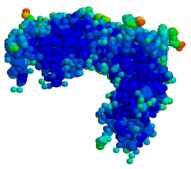Chemistry:Rasburicase
 | |
| Clinical data | |
|---|---|
| Trade names | Elitek, Fasturtec |
| AHFS/Drugs.com | Monograph |
| License data |
|
| Pregnancy category |
|
| Routes of administration | Intravenous infusion |
| ATC code | |
| Legal status | |
| Legal status | |
| Pharmacokinetic data | |
| Bioavailability | N/A |
| Elimination half-life | 18 hrs |
| Identifiers | |
| |
| CAS Number | |
| IUPHAR/BPS | |
| DrugBank | |
| ChemSpider |
|
| UNII | |
| KEGG | |
| ChEMBL | |
| Chemical and physical data | |
| Formula | C1521H2381N417O461S7 |
| Molar mass | 34109.66 g·mol−1 |
| | |
Rasburicase (trade names Elitek in the US and Fasturtec in the EU) is a medication that helps to clear uric acid from the blood. It is a recombinant version of urate oxidase, an enzyme that metabolizes uric acid to allantoin. Urate oxidase is known to be present in many mammals but does not naturally occur in humans.[1] Rasburicase is produced by a genetically modified Saccharomyces cerevisiae strain. The complementary DNA (cDNA) coding for rasburicase was cloned from a strain of Aspergillus flavus.[1]
Rasburicase (Q00511) is a tetrameric protein with identical subunits. Each subunit is made up of a single 301 amino acid polypeptide chain with a molecular mass of about 34 kDa. The drug product is a sterile, white to off-white, lyophilized powder intended for intravenous administration following reconstitution with a diluent. Elitek (rasburicase) is supplied in 3 mL and 10 mL colorless, glass vials containing rasburicase at a concentration of 1.5 mg/mL after reconstitution.[2]
It is on the World Health Organization's List of Essential Medicines.[3]
Medical uses
Rasburicase is approved for use by the U.S. Food and Drug Administration (and European counterparts) for the prevention and treatment of tumor lysis syndrome (TLS)[4] in people receiving chemotherapy for hematologic cancers such as leukemias and lymphomas. However, it is not clear if it results in important benefits such as decreased kidney problems or decreased risk of death as of 2017.[5]
It is being investigated for treating severely high blood levels of uric acid from other sources. For example, it has been used for hyperuricemia in gout,[6] in other rheumatologic conditions, and in rhabdomyolysis with kidney failure.[7]
Contraindication
Rasburicase use is contraindicated in patients with a G6PDH deficiency.[8]
Side effects
Rasburicase administration can cause anaphylaxis (incidence unknown); methemoglobinemia may occur in susceptible individuals such as those with G6PDH deficiency due to the production of hydrogen peroxide in the urate oxidase reaction.[1] Testing patients for G6PDH deficiency prior to starting a course of rasburicase has been recommended.[1]
Pharmacology
Mechanism of Action
In humans, uric acid is the final step in the catabolic pathway of purines. Rasburicase catalyzes enzymatic oxidation of poorly soluble uric acid into an inactive and more soluble metabolite allantoin with carbon dioxide and hydrogen peroxide as byproducts in the chemical reaction.[1]
Pharmacodynamics
The measurement of plasma uric acid was used to evaluate the effectiveness of rasburicase in clinical studies. Following administration of either 0.15 or 0.20 mg/kg rasburicase daily for up to 5 days, plasma uric acid levels decreased within 4 hours and were maintained below 7.5 mg/dL in 98% of adult and 90% of pediatric patients for at least 7 days. There was no evidence of a dose response effect on uric acid control for doses between 0.15 and 0.20 mg/kg rasburicase.[2]
Pharmacokinetics
The pharmacokinetics of rasburicase were evaluated in both pediatric and adult patients with leukemia, lymphoma or other hematological malignancies. Rasburicase exposure, as measured by AUC0-24 hr and Cmax, tended to increase with a dose range from 0.15 to 0.2 mg/kg. The mean terminal half-life was similar between pediatric and adult patients and ranged from 15.7 to 22.5 hours. The mean volume of distribution of rasburicase ranged from 110 to 127 mL/kg in pediatric patients and from 75.8 to 138 mL/kg in adult patients, respectively. Minimal accumulation of rasburicase ( < 1.3 fold) was observed between days 1 and 5 of dosing. In adults, age, gender, baseline liver enzymes and creatinine clearance did not impact the pharmacokinetics of rasburicase. A cross-study comparison revealed that after administration of rasburicase at 0.15 or 0.20 mg/kg, the geometric mean values of body-weight normalized clearance were approximately 40% lower in Japanese (n=20) than that in Caucasians (n=22).[2]
Society and culture
Economics
Rasburicase is much more expensive than the conventional uric acid lowering treatment for tophaceous gout.[9]
References
- ↑ 1.0 1.1 1.2 1.3 1.4 "Onco-nephrology: tumor lysis syndrome". Clinical Journal of the American Society of Nephrology 7 (10): 1730–1739. October 2012. doi:10.2215/CJN.03150312. PMID 22879434.
- ↑ 2.0 2.1 2.2 "Elitek (rasburicase)". Rxlist. http://www.rxlist.com/elitek-drug/clinical-pharmacology.htm.
- ↑ World Health Organization model list of essential medicines: 22nd list (2021). Geneva: World Health Organization. 2021. WHO/MHP/HPS/EML/2021.02.
- ↑ "Abbreviated rasburicase dosing for the prevention and treatment of hyperuricemia in adults at risk for tumor lysis syndrome". Supportive Cancer Therapy 3 (3): 178–182. April 2006. doi:10.3816/SCT.2006.n.016. PMID 18632493.
- ↑ "Urate oxidase for the prevention and treatment of tumour lysis syndrome in children with cancer". The Cochrane Database of Systematic Reviews 2017 (3): CD006945. March 2017. doi:10.1002/14651858.CD006945.pub4. PMID 28272834.
- ↑ "Rasburicase represents a new tool for hyperuricemia in tumor lysis syndrome and in gout". International Journal of Medical Sciences 4 (2): 83–93. March 2007. doi:10.7150/ijms.4.83. PMID 17396159.
- ↑ "Rasburicase improves hyperuricemia in patients with acute kidney injury secondary to rhabdomyolysis caused by ecstasy intoxication and exertional heat stroke". Pediatric Critical Care Medicine 12 (6): e424–e427. November 2011. doi:10.1097/PCC.0b013e3182192c8d. PMID 21572370.
- ↑ "Rasburicase Therapy and G6PD and CYB5R Genotype". Medical Genetics Summaries. National Center for Biotechnology Information (US). 29 September 2020. https://www.ncbi.nlm.nih.gov/books/NBK562585/.
- ↑ "A costly therapeutic dilemma in tophaceous gout: is etanercept or rasburicase preferable?". Annals of the Rheumatic Diseases 64 (3): 516; author reply 516. March 2005. doi:10.1136/ard.2003.017087corr1. PMID 15708917.
External links
- "Rasburicase". Drug Information Portal. U.S. National Library of Medicine. https://druginfo.nlm.nih.gov/drugportal/name/rasburicase.

